Analyzing the Importance of Health Economics in Modern Healthcare
VerifiedAdded on 2023/05/28
|11
|2677
|496
Essay
AI Summary
This essay provides a comprehensive overview of health economics, defining it as a branch of economics focused on healthcare consumption and resource allocation. It highlights the increasing importance of health economics due to the growing array of treatment options and the need for fair decision-making processes. The study outlines three major principles used in economic analysis: marginal analysis, perspective, and opportunity cost. It further examines key economic concepts such as cost-benefit analysis, risk-benefit analysis, and cost-effectiveness, emphasizing their application and limitations within the healthcare system. The essay also touches upon the price theory, explaining the relationship between supply and demand in healthcare services and pharmaceuticals. Finally, it presents evidence of health economics in healthcare, discussing challenges like financial sustainability and the impact of factors such as an aging population and technological advancements. The conclusion reinforces the role of health economics in addressing questions related to the production, distribution, and utilization of healthcare goods and services.
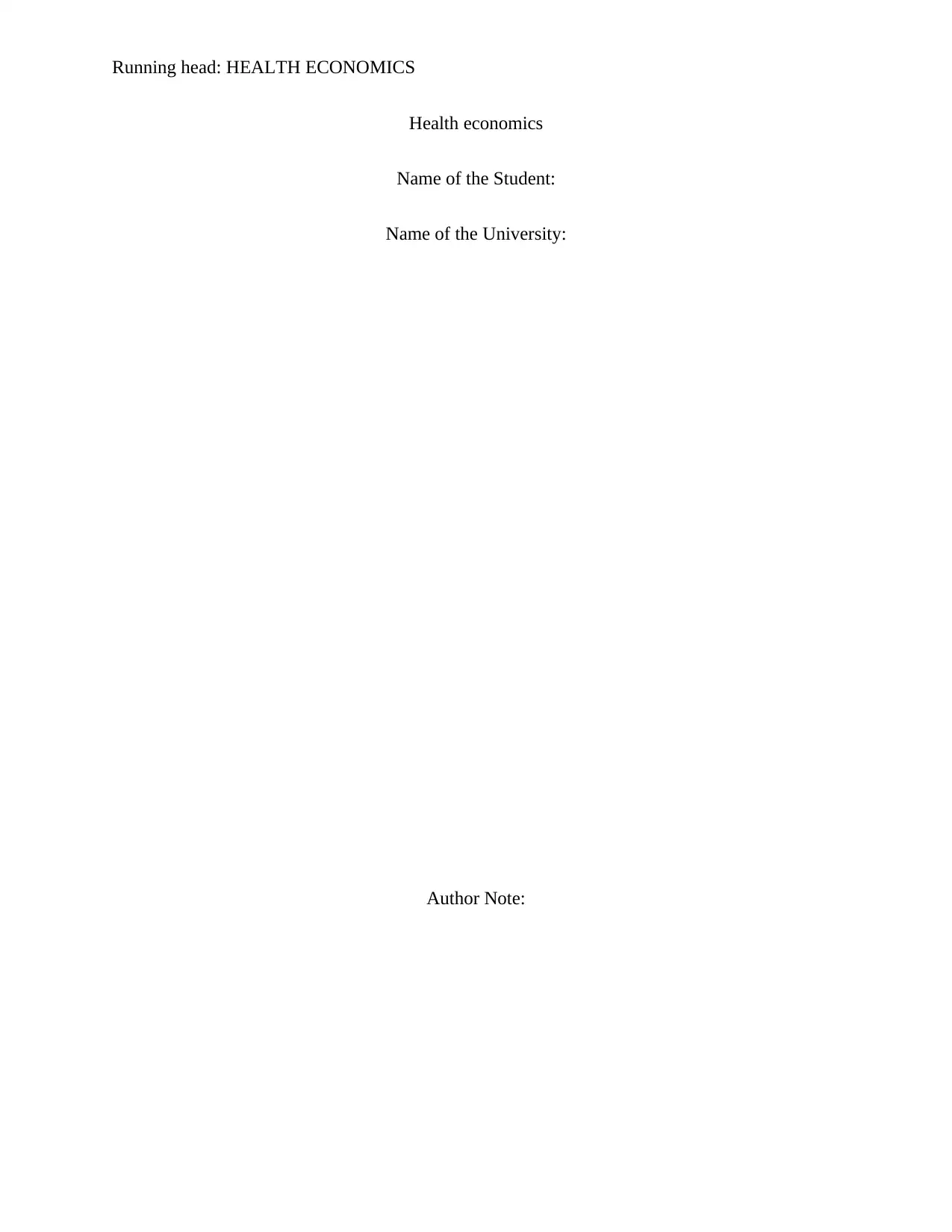
Running head: HEALTH ECONOMICS
Health economics
Name of the Student:
Name of the University:
Author Note:
Health economics
Name of the Student:
Name of the University:
Author Note:
Paraphrase This Document
Need a fresh take? Get an instant paraphrase of this document with our AI Paraphraser
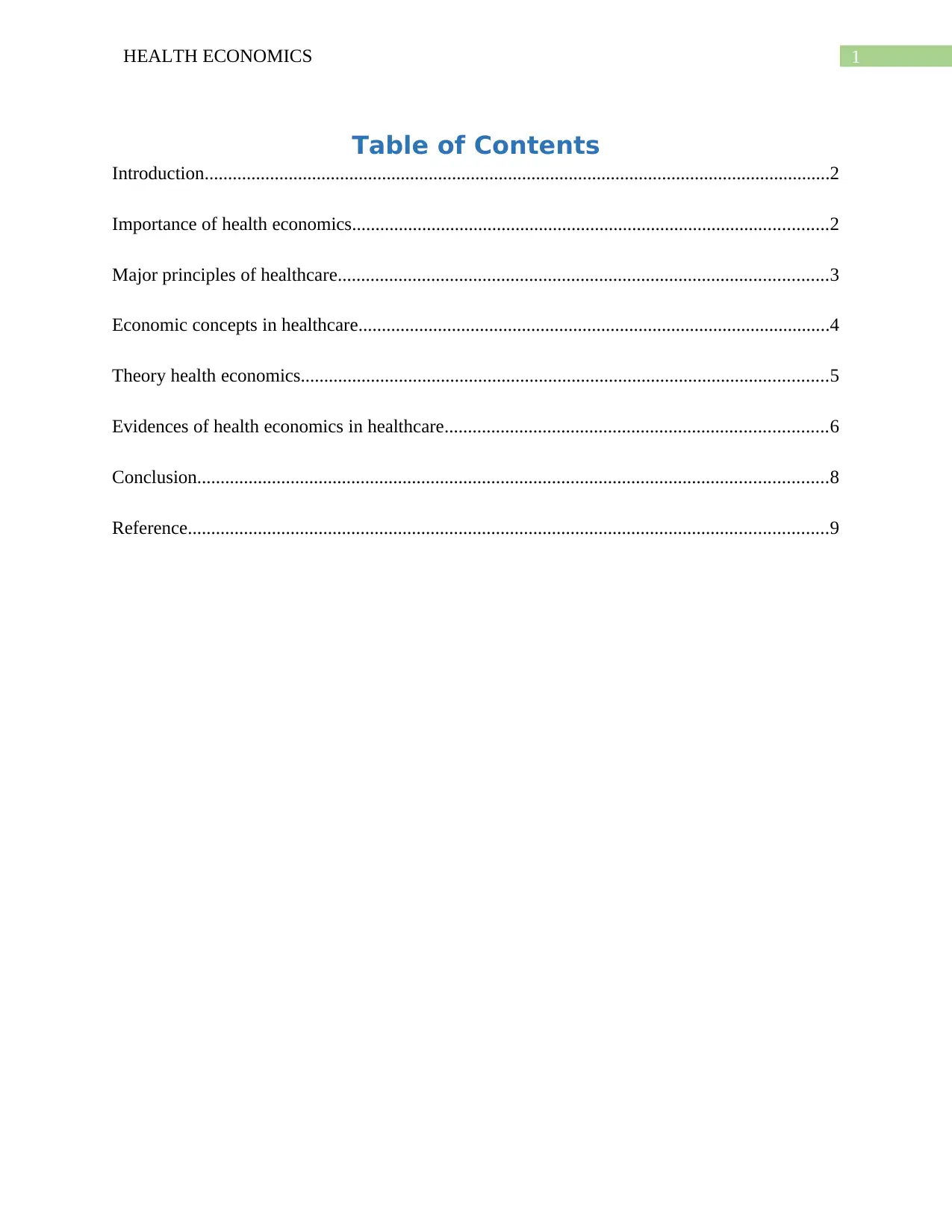
1HEALTH ECONOMICS
Table of Contents
Introduction......................................................................................................................................2
Importance of health economics......................................................................................................2
Major principles of healthcare.........................................................................................................3
Economic concepts in healthcare.....................................................................................................4
Theory health economics.................................................................................................................5
Evidences of health economics in healthcare..................................................................................6
Conclusion.......................................................................................................................................8
Reference.........................................................................................................................................9
Table of Contents
Introduction......................................................................................................................................2
Importance of health economics......................................................................................................2
Major principles of healthcare.........................................................................................................3
Economic concepts in healthcare.....................................................................................................4
Theory health economics.................................................................................................................5
Evidences of health economics in healthcare..................................................................................6
Conclusion.......................................................................................................................................8
Reference.........................................................................................................................................9
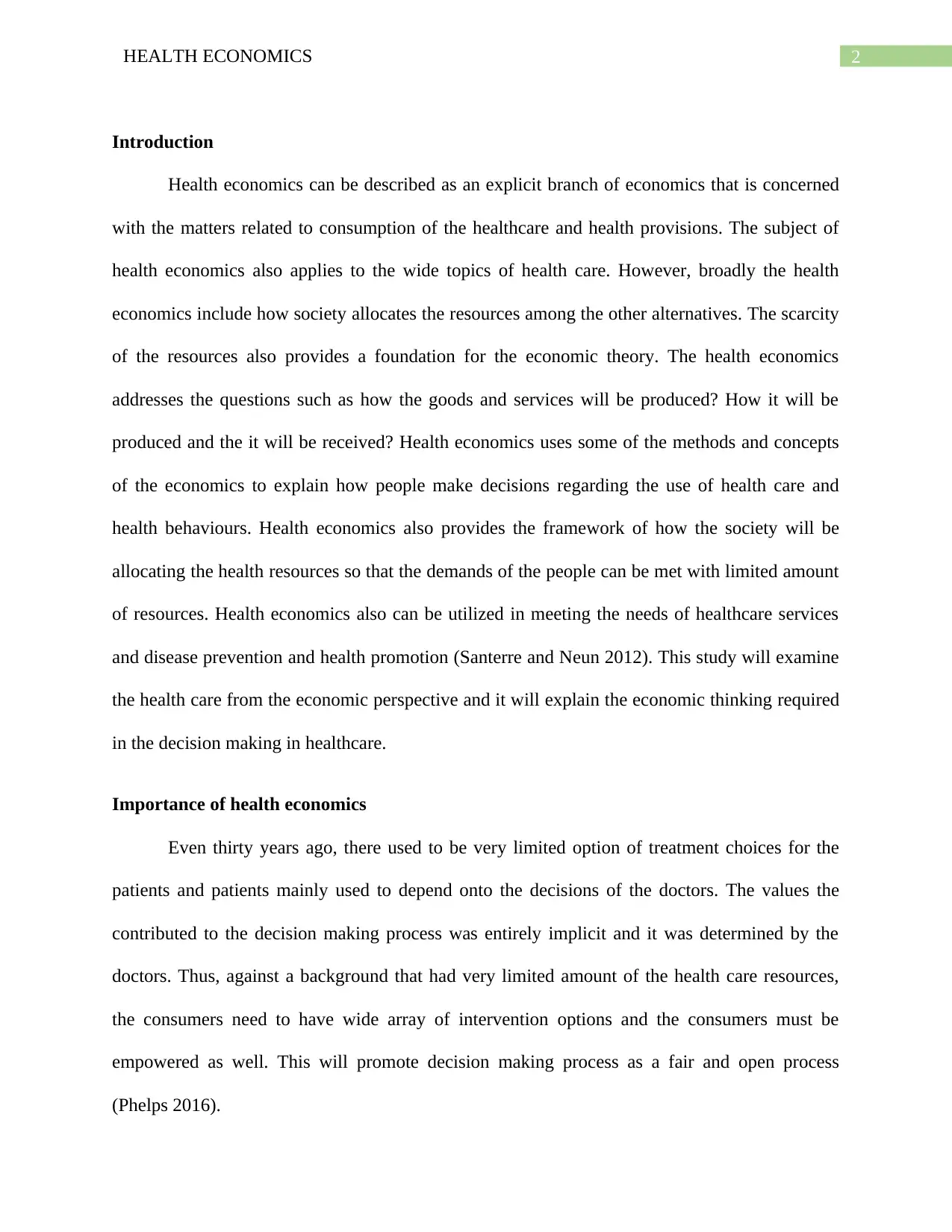
2HEALTH ECONOMICS
Introduction
Health economics can be described as an explicit branch of economics that is concerned
with the matters related to consumption of the healthcare and health provisions. The subject of
health economics also applies to the wide topics of health care. However, broadly the health
economics include how society allocates the resources among the other alternatives. The scarcity
of the resources also provides a foundation for the economic theory. The health economics
addresses the questions such as how the goods and services will be produced? How it will be
produced and the it will be received? Health economics uses some of the methods and concepts
of the economics to explain how people make decisions regarding the use of health care and
health behaviours. Health economics also provides the framework of how the society will be
allocating the health resources so that the demands of the people can be met with limited amount
of resources. Health economics also can be utilized in meeting the needs of healthcare services
and disease prevention and health promotion (Santerre and Neun 2012). This study will examine
the health care from the economic perspective and it will explain the economic thinking required
in the decision making in healthcare.
Importance of health economics
Even thirty years ago, there used to be very limited option of treatment choices for the
patients and patients mainly used to depend onto the decisions of the doctors. The values the
contributed to the decision making process was entirely implicit and it was determined by the
doctors. Thus, against a background that had very limited amount of the health care resources,
the consumers need to have wide array of intervention options and the consumers must be
empowered as well. This will promote decision making process as a fair and open process
(Phelps 2016).
Introduction
Health economics can be described as an explicit branch of economics that is concerned
with the matters related to consumption of the healthcare and health provisions. The subject of
health economics also applies to the wide topics of health care. However, broadly the health
economics include how society allocates the resources among the other alternatives. The scarcity
of the resources also provides a foundation for the economic theory. The health economics
addresses the questions such as how the goods and services will be produced? How it will be
produced and the it will be received? Health economics uses some of the methods and concepts
of the economics to explain how people make decisions regarding the use of health care and
health behaviours. Health economics also provides the framework of how the society will be
allocating the health resources so that the demands of the people can be met with limited amount
of resources. Health economics also can be utilized in meeting the needs of healthcare services
and disease prevention and health promotion (Santerre and Neun 2012). This study will examine
the health care from the economic perspective and it will explain the economic thinking required
in the decision making in healthcare.
Importance of health economics
Even thirty years ago, there used to be very limited option of treatment choices for the
patients and patients mainly used to depend onto the decisions of the doctors. The values the
contributed to the decision making process was entirely implicit and it was determined by the
doctors. Thus, against a background that had very limited amount of the health care resources,
the consumers need to have wide array of intervention options and the consumers must be
empowered as well. This will promote decision making process as a fair and open process
(Phelps 2016).
⊘ This is a preview!⊘
Do you want full access?
Subscribe today to unlock all pages.

Trusted by 1+ million students worldwide
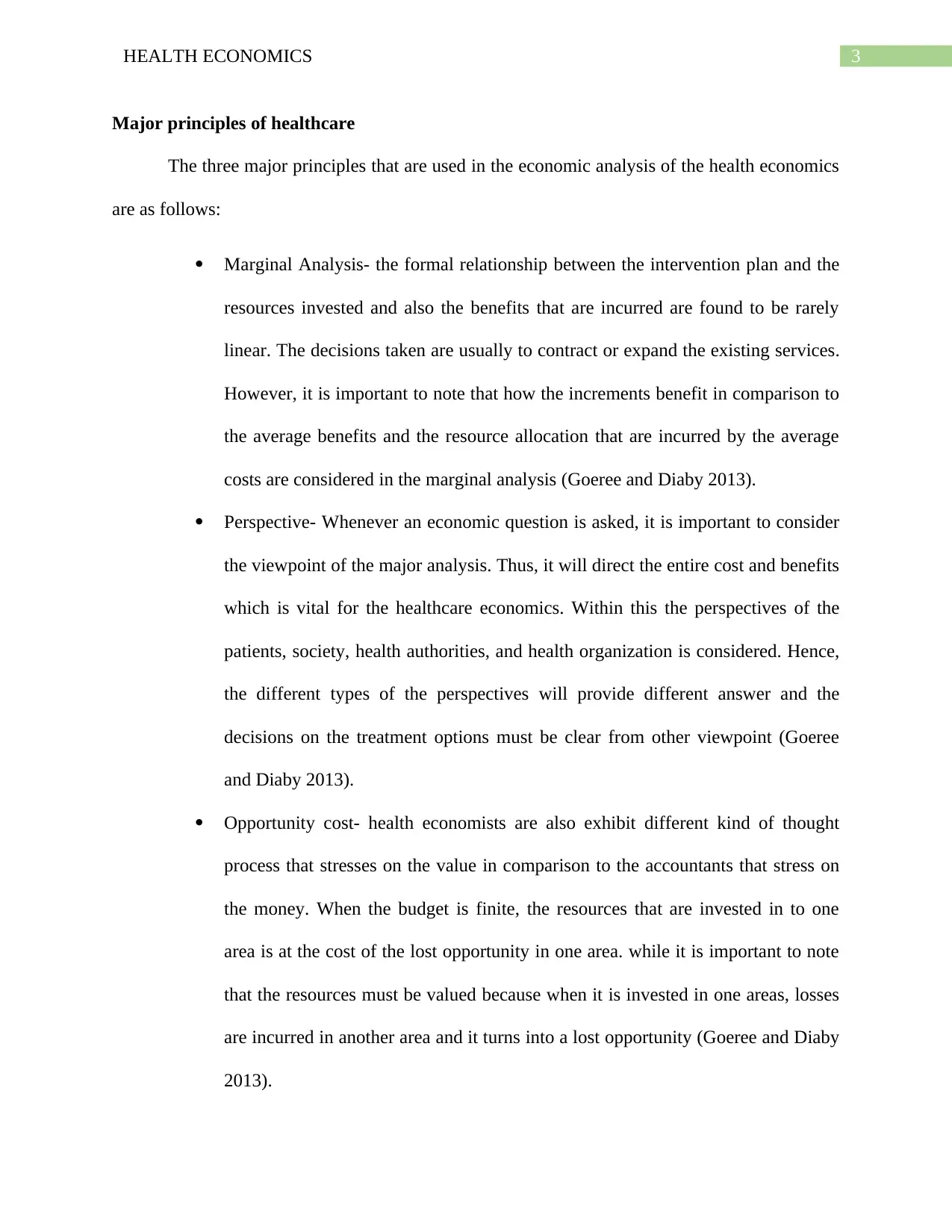
3HEALTH ECONOMICS
Major principles of healthcare
The three major principles that are used in the economic analysis of the health economics
are as follows:
Marginal Analysis- the formal relationship between the intervention plan and the
resources invested and also the benefits that are incurred are found to be rarely
linear. The decisions taken are usually to contract or expand the existing services.
However, it is important to note that how the increments benefit in comparison to
the average benefits and the resource allocation that are incurred by the average
costs are considered in the marginal analysis (Goeree and Diaby 2013).
Perspective- Whenever an economic question is asked, it is important to consider
the viewpoint of the major analysis. Thus, it will direct the entire cost and benefits
which is vital for the healthcare economics. Within this the perspectives of the
patients, society, health authorities, and health organization is considered. Hence,
the different types of the perspectives will provide different answer and the
decisions on the treatment options must be clear from other viewpoint (Goeree
and Diaby 2013).
Opportunity cost- health economists are also exhibit different kind of thought
process that stresses on the value in comparison to the accountants that stress on
the money. When the budget is finite, the resources that are invested in to one
area is at the cost of the lost opportunity in one area. while it is important to note
that the resources must be valued because when it is invested in one areas, losses
are incurred in another area and it turns into a lost opportunity (Goeree and Diaby
2013).
Major principles of healthcare
The three major principles that are used in the economic analysis of the health economics
are as follows:
Marginal Analysis- the formal relationship between the intervention plan and the
resources invested and also the benefits that are incurred are found to be rarely
linear. The decisions taken are usually to contract or expand the existing services.
However, it is important to note that how the increments benefit in comparison to
the average benefits and the resource allocation that are incurred by the average
costs are considered in the marginal analysis (Goeree and Diaby 2013).
Perspective- Whenever an economic question is asked, it is important to consider
the viewpoint of the major analysis. Thus, it will direct the entire cost and benefits
which is vital for the healthcare economics. Within this the perspectives of the
patients, society, health authorities, and health organization is considered. Hence,
the different types of the perspectives will provide different answer and the
decisions on the treatment options must be clear from other viewpoint (Goeree
and Diaby 2013).
Opportunity cost- health economists are also exhibit different kind of thought
process that stresses on the value in comparison to the accountants that stress on
the money. When the budget is finite, the resources that are invested in to one
area is at the cost of the lost opportunity in one area. while it is important to note
that the resources must be valued because when it is invested in one areas, losses
are incurred in another area and it turns into a lost opportunity (Goeree and Diaby
2013).
Paraphrase This Document
Need a fresh take? Get an instant paraphrase of this document with our AI Paraphraser
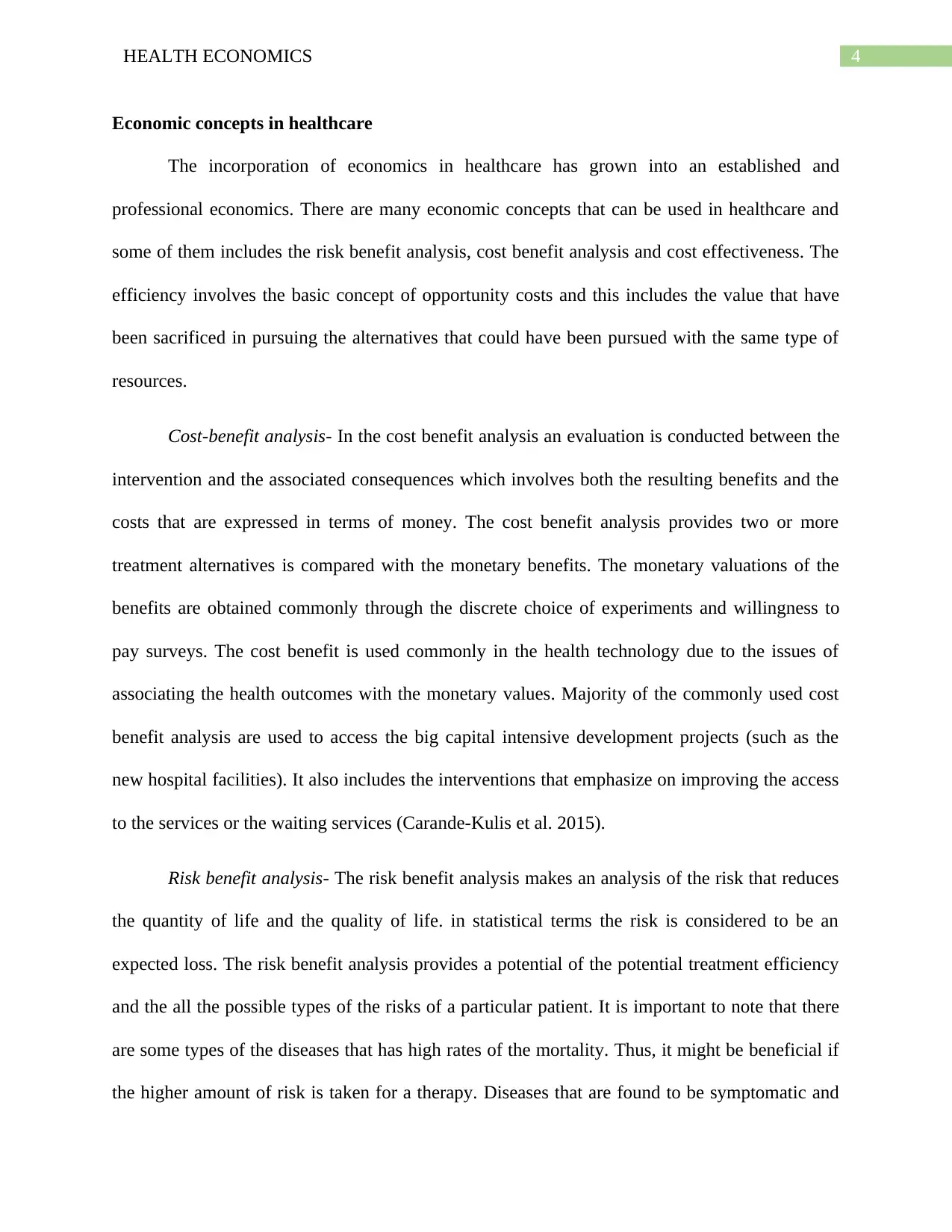
4HEALTH ECONOMICS
Economic concepts in healthcare
The incorporation of economics in healthcare has grown into an established and
professional economics. There are many economic concepts that can be used in healthcare and
some of them includes the risk benefit analysis, cost benefit analysis and cost effectiveness. The
efficiency involves the basic concept of opportunity costs and this includes the value that have
been sacrificed in pursuing the alternatives that could have been pursued with the same type of
resources.
Cost-benefit analysis- In the cost benefit analysis an evaluation is conducted between the
intervention and the associated consequences which involves both the resulting benefits and the
costs that are expressed in terms of money. The cost benefit analysis provides two or more
treatment alternatives is compared with the monetary benefits. The monetary valuations of the
benefits are obtained commonly through the discrete choice of experiments and willingness to
pay surveys. The cost benefit is used commonly in the health technology due to the issues of
associating the health outcomes with the monetary values. Majority of the commonly used cost
benefit analysis are used to access the big capital intensive development projects (such as the
new hospital facilities). It also includes the interventions that emphasize on improving the access
to the services or the waiting services (Carande-Kulis et al. 2015).
Risk benefit analysis- The risk benefit analysis makes an analysis of the risk that reduces
the quantity of life and the quality of life. in statistical terms the risk is considered to be an
expected loss. The risk benefit analysis provides a potential of the potential treatment efficiency
and the all the possible types of the risks of a particular patient. It is important to note that there
are some types of the diseases that has high rates of the mortality. Thus, it might be beneficial if
the higher amount of risk is taken for a therapy. Diseases that are found to be symptomatic and
Economic concepts in healthcare
The incorporation of economics in healthcare has grown into an established and
professional economics. There are many economic concepts that can be used in healthcare and
some of them includes the risk benefit analysis, cost benefit analysis and cost effectiveness. The
efficiency involves the basic concept of opportunity costs and this includes the value that have
been sacrificed in pursuing the alternatives that could have been pursued with the same type of
resources.
Cost-benefit analysis- In the cost benefit analysis an evaluation is conducted between the
intervention and the associated consequences which involves both the resulting benefits and the
costs that are expressed in terms of money. The cost benefit analysis provides two or more
treatment alternatives is compared with the monetary benefits. The monetary valuations of the
benefits are obtained commonly through the discrete choice of experiments and willingness to
pay surveys. The cost benefit is used commonly in the health technology due to the issues of
associating the health outcomes with the monetary values. Majority of the commonly used cost
benefit analysis are used to access the big capital intensive development projects (such as the
new hospital facilities). It also includes the interventions that emphasize on improving the access
to the services or the waiting services (Carande-Kulis et al. 2015).
Risk benefit analysis- The risk benefit analysis makes an analysis of the risk that reduces
the quantity of life and the quality of life. in statistical terms the risk is considered to be an
expected loss. The risk benefit analysis provides a potential of the potential treatment efficiency
and the all the possible types of the risks of a particular patient. It is important to note that there
are some types of the diseases that has high rates of the mortality. Thus, it might be beneficial if
the higher amount of risk is taken for a therapy. Diseases that are found to be symptomatic and
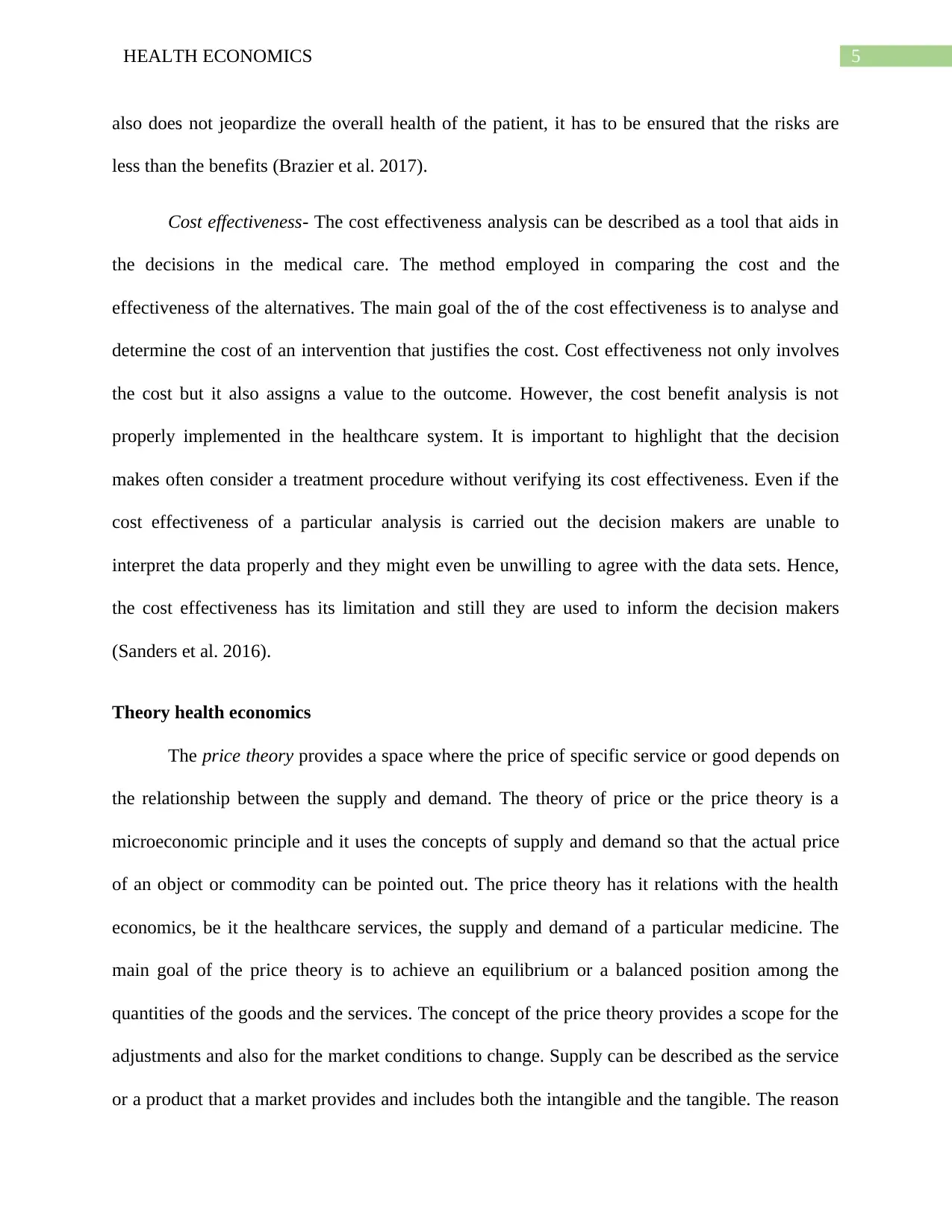
5HEALTH ECONOMICS
also does not jeopardize the overall health of the patient, it has to be ensured that the risks are
less than the benefits (Brazier et al. 2017).
Cost effectiveness- The cost effectiveness analysis can be described as a tool that aids in
the decisions in the medical care. The method employed in comparing the cost and the
effectiveness of the alternatives. The main goal of the of the cost effectiveness is to analyse and
determine the cost of an intervention that justifies the cost. Cost effectiveness not only involves
the cost but it also assigns a value to the outcome. However, the cost benefit analysis is not
properly implemented in the healthcare system. It is important to highlight that the decision
makes often consider a treatment procedure without verifying its cost effectiveness. Even if the
cost effectiveness of a particular analysis is carried out the decision makers are unable to
interpret the data properly and they might even be unwilling to agree with the data sets. Hence,
the cost effectiveness has its limitation and still they are used to inform the decision makers
(Sanders et al. 2016).
Theory health economics
The price theory provides a space where the price of specific service or good depends on
the relationship between the supply and demand. The theory of price or the price theory is a
microeconomic principle and it uses the concepts of supply and demand so that the actual price
of an object or commodity can be pointed out. The price theory has it relations with the health
economics, be it the healthcare services, the supply and demand of a particular medicine. The
main goal of the price theory is to achieve an equilibrium or a balanced position among the
quantities of the goods and the services. The concept of the price theory provides a scope for the
adjustments and also for the market conditions to change. Supply can be described as the service
or a product that a market provides and includes both the intangible and the tangible. The reason
also does not jeopardize the overall health of the patient, it has to be ensured that the risks are
less than the benefits (Brazier et al. 2017).
Cost effectiveness- The cost effectiveness analysis can be described as a tool that aids in
the decisions in the medical care. The method employed in comparing the cost and the
effectiveness of the alternatives. The main goal of the of the cost effectiveness is to analyse and
determine the cost of an intervention that justifies the cost. Cost effectiveness not only involves
the cost but it also assigns a value to the outcome. However, the cost benefit analysis is not
properly implemented in the healthcare system. It is important to highlight that the decision
makes often consider a treatment procedure without verifying its cost effectiveness. Even if the
cost effectiveness of a particular analysis is carried out the decision makers are unable to
interpret the data properly and they might even be unwilling to agree with the data sets. Hence,
the cost effectiveness has its limitation and still they are used to inform the decision makers
(Sanders et al. 2016).
Theory health economics
The price theory provides a space where the price of specific service or good depends on
the relationship between the supply and demand. The theory of price or the price theory is a
microeconomic principle and it uses the concepts of supply and demand so that the actual price
of an object or commodity can be pointed out. The price theory has it relations with the health
economics, be it the healthcare services, the supply and demand of a particular medicine. The
main goal of the price theory is to achieve an equilibrium or a balanced position among the
quantities of the goods and the services. The concept of the price theory provides a scope for the
adjustments and also for the market conditions to change. Supply can be described as the service
or a product that a market provides and includes both the intangible and the tangible. The reason
⊘ This is a preview!⊘
Do you want full access?
Subscribe today to unlock all pages.

Trusted by 1+ million students worldwide
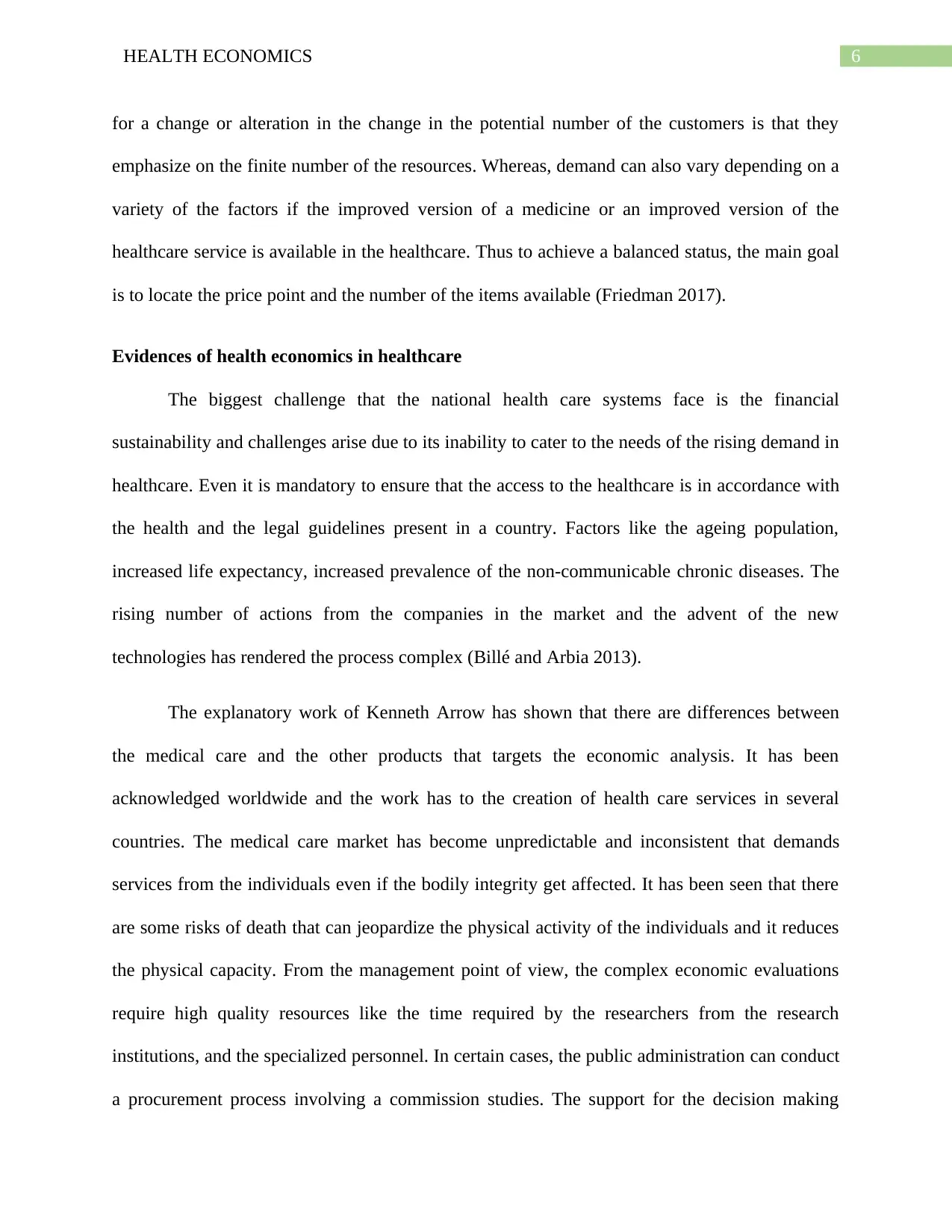
6HEALTH ECONOMICS
for a change or alteration in the change in the potential number of the customers is that they
emphasize on the finite number of the resources. Whereas, demand can also vary depending on a
variety of the factors if the improved version of a medicine or an improved version of the
healthcare service is available in the healthcare. Thus to achieve a balanced status, the main goal
is to locate the price point and the number of the items available (Friedman 2017).
Evidences of health economics in healthcare
The biggest challenge that the national health care systems face is the financial
sustainability and challenges arise due to its inability to cater to the needs of the rising demand in
healthcare. Even it is mandatory to ensure that the access to the healthcare is in accordance with
the health and the legal guidelines present in a country. Factors like the ageing population,
increased life expectancy, increased prevalence of the non-communicable chronic diseases. The
rising number of actions from the companies in the market and the advent of the new
technologies has rendered the process complex (Billé and Arbia 2013).
The explanatory work of Kenneth Arrow has shown that there are differences between
the medical care and the other products that targets the economic analysis. It has been
acknowledged worldwide and the work has to the creation of health care services in several
countries. The medical care market has become unpredictable and inconsistent that demands
services from the individuals even if the bodily integrity get affected. It has been seen that there
are some risks of death that can jeopardize the physical activity of the individuals and it reduces
the physical capacity. From the management point of view, the complex economic evaluations
require high quality resources like the time required by the researchers from the research
institutions, and the specialized personnel. In certain cases, the public administration can conduct
a procurement process involving a commission studies. The support for the decision making
for a change or alteration in the change in the potential number of the customers is that they
emphasize on the finite number of the resources. Whereas, demand can also vary depending on a
variety of the factors if the improved version of a medicine or an improved version of the
healthcare service is available in the healthcare. Thus to achieve a balanced status, the main goal
is to locate the price point and the number of the items available (Friedman 2017).
Evidences of health economics in healthcare
The biggest challenge that the national health care systems face is the financial
sustainability and challenges arise due to its inability to cater to the needs of the rising demand in
healthcare. Even it is mandatory to ensure that the access to the healthcare is in accordance with
the health and the legal guidelines present in a country. Factors like the ageing population,
increased life expectancy, increased prevalence of the non-communicable chronic diseases. The
rising number of actions from the companies in the market and the advent of the new
technologies has rendered the process complex (Billé and Arbia 2013).
The explanatory work of Kenneth Arrow has shown that there are differences between
the medical care and the other products that targets the economic analysis. It has been
acknowledged worldwide and the work has to the creation of health care services in several
countries. The medical care market has become unpredictable and inconsistent that demands
services from the individuals even if the bodily integrity get affected. It has been seen that there
are some risks of death that can jeopardize the physical activity of the individuals and it reduces
the physical capacity. From the management point of view, the complex economic evaluations
require high quality resources like the time required by the researchers from the research
institutions, and the specialized personnel. In certain cases, the public administration can conduct
a procurement process involving a commission studies. The support for the decision making
Paraphrase This Document
Need a fresh take? Get an instant paraphrase of this document with our AI Paraphraser
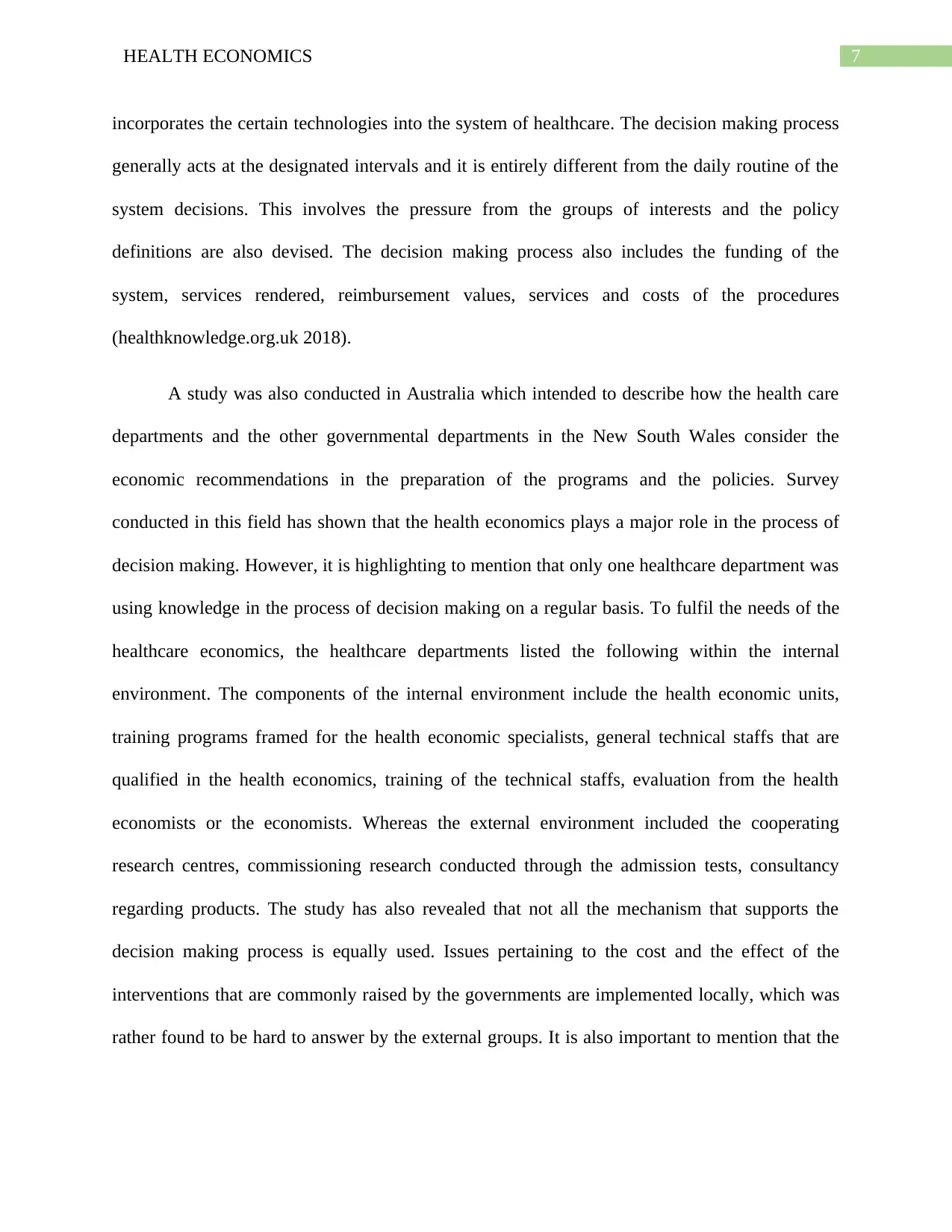
7HEALTH ECONOMICS
incorporates the certain technologies into the system of healthcare. The decision making process
generally acts at the designated intervals and it is entirely different from the daily routine of the
system decisions. This involves the pressure from the groups of interests and the policy
definitions are also devised. The decision making process also includes the funding of the
system, services rendered, reimbursement values, services and costs of the procedures
(healthknowledge.org.uk 2018).
A study was also conducted in Australia which intended to describe how the health care
departments and the other governmental departments in the New South Wales consider the
economic recommendations in the preparation of the programs and the policies. Survey
conducted in this field has shown that the health economics plays a major role in the process of
decision making. However, it is highlighting to mention that only one healthcare department was
using knowledge in the process of decision making on a regular basis. To fulfil the needs of the
healthcare economics, the healthcare departments listed the following within the internal
environment. The components of the internal environment include the health economic units,
training programs framed for the health economic specialists, general technical staffs that are
qualified in the health economics, training of the technical staffs, evaluation from the health
economists or the economists. Whereas the external environment included the cooperating
research centres, commissioning research conducted through the admission tests, consultancy
regarding products. The study has also revealed that not all the mechanism that supports the
decision making process is equally used. Issues pertaining to the cost and the effect of the
interventions that are commonly raised by the governments are implemented locally, which was
rather found to be hard to answer by the external groups. It is also important to mention that the
incorporates the certain technologies into the system of healthcare. The decision making process
generally acts at the designated intervals and it is entirely different from the daily routine of the
system decisions. This involves the pressure from the groups of interests and the policy
definitions are also devised. The decision making process also includes the funding of the
system, services rendered, reimbursement values, services and costs of the procedures
(healthknowledge.org.uk 2018).
A study was also conducted in Australia which intended to describe how the health care
departments and the other governmental departments in the New South Wales consider the
economic recommendations in the preparation of the programs and the policies. Survey
conducted in this field has shown that the health economics plays a major role in the process of
decision making. However, it is highlighting to mention that only one healthcare department was
using knowledge in the process of decision making on a regular basis. To fulfil the needs of the
healthcare economics, the healthcare departments listed the following within the internal
environment. The components of the internal environment include the health economic units,
training programs framed for the health economic specialists, general technical staffs that are
qualified in the health economics, training of the technical staffs, evaluation from the health
economists or the economists. Whereas the external environment included the cooperating
research centres, commissioning research conducted through the admission tests, consultancy
regarding products. The study has also revealed that not all the mechanism that supports the
decision making process is equally used. Issues pertaining to the cost and the effect of the
interventions that are commonly raised by the governments are implemented locally, which was
rather found to be hard to answer by the external groups. It is also important to mention that the
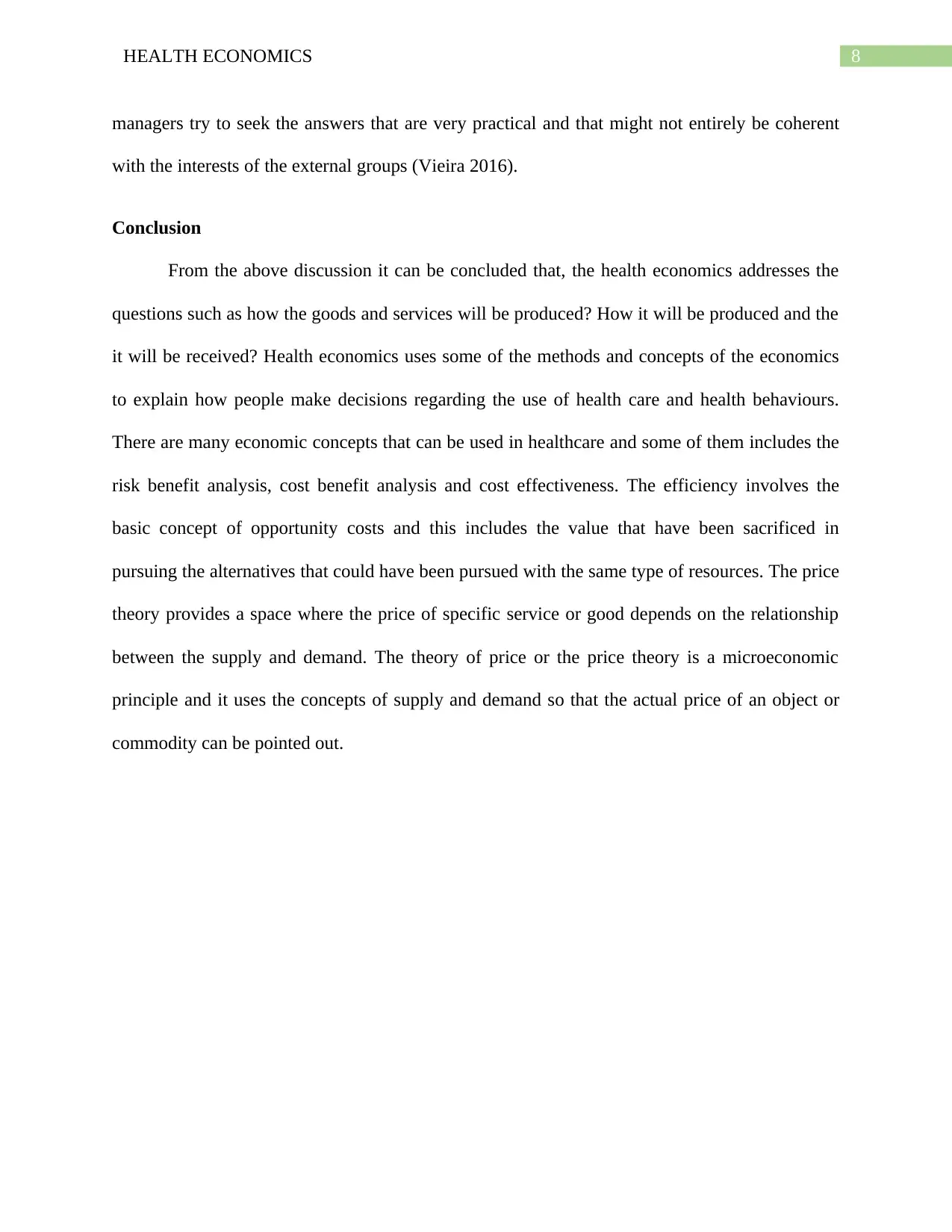
8HEALTH ECONOMICS
managers try to seek the answers that are very practical and that might not entirely be coherent
with the interests of the external groups (Vieira 2016).
Conclusion
From the above discussion it can be concluded that, the health economics addresses the
questions such as how the goods and services will be produced? How it will be produced and the
it will be received? Health economics uses some of the methods and concepts of the economics
to explain how people make decisions regarding the use of health care and health behaviours.
There are many economic concepts that can be used in healthcare and some of them includes the
risk benefit analysis, cost benefit analysis and cost effectiveness. The efficiency involves the
basic concept of opportunity costs and this includes the value that have been sacrificed in
pursuing the alternatives that could have been pursued with the same type of resources. The price
theory provides a space where the price of specific service or good depends on the relationship
between the supply and demand. The theory of price or the price theory is a microeconomic
principle and it uses the concepts of supply and demand so that the actual price of an object or
commodity can be pointed out.
managers try to seek the answers that are very practical and that might not entirely be coherent
with the interests of the external groups (Vieira 2016).
Conclusion
From the above discussion it can be concluded that, the health economics addresses the
questions such as how the goods and services will be produced? How it will be produced and the
it will be received? Health economics uses some of the methods and concepts of the economics
to explain how people make decisions regarding the use of health care and health behaviours.
There are many economic concepts that can be used in healthcare and some of them includes the
risk benefit analysis, cost benefit analysis and cost effectiveness. The efficiency involves the
basic concept of opportunity costs and this includes the value that have been sacrificed in
pursuing the alternatives that could have been pursued with the same type of resources. The price
theory provides a space where the price of specific service or good depends on the relationship
between the supply and demand. The theory of price or the price theory is a microeconomic
principle and it uses the concepts of supply and demand so that the actual price of an object or
commodity can be pointed out.
⊘ This is a preview!⊘
Do you want full access?
Subscribe today to unlock all pages.

Trusted by 1+ million students worldwide
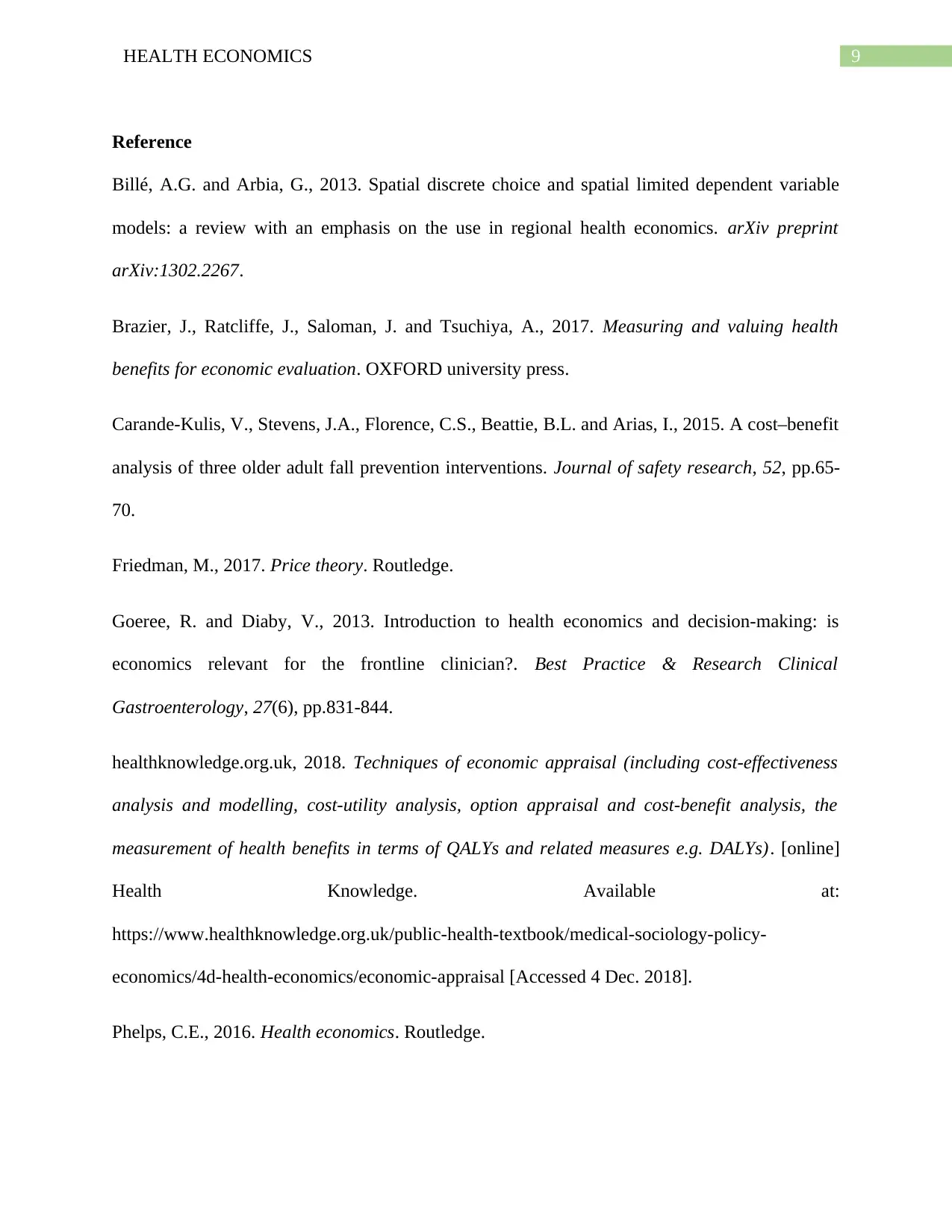
9HEALTH ECONOMICS
Reference
Billé, A.G. and Arbia, G., 2013. Spatial discrete choice and spatial limited dependent variable
models: a review with an emphasis on the use in regional health economics. arXiv preprint
arXiv:1302.2267.
Brazier, J., Ratcliffe, J., Saloman, J. and Tsuchiya, A., 2017. Measuring and valuing health
benefits for economic evaluation. OXFORD university press.
Carande-Kulis, V., Stevens, J.A., Florence, C.S., Beattie, B.L. and Arias, I., 2015. A cost–benefit
analysis of three older adult fall prevention interventions. Journal of safety research, 52, pp.65-
70.
Friedman, M., 2017. Price theory. Routledge.
Goeree, R. and Diaby, V., 2013. Introduction to health economics and decision-making: is
economics relevant for the frontline clinician?. Best Practice & Research Clinical
Gastroenterology, 27(6), pp.831-844.
healthknowledge.org.uk, 2018. Techniques of economic appraisal (including cost-effectiveness
analysis and modelling, cost-utility analysis, option appraisal and cost-benefit analysis, the
measurement of health benefits in terms of QALYs and related measures e.g. DALYs). [online]
Health Knowledge. Available at:
https://www.healthknowledge.org.uk/public-health-textbook/medical-sociology-policy-
economics/4d-health-economics/economic-appraisal [Accessed 4 Dec. 2018].
Phelps, C.E., 2016. Health economics. Routledge.
Reference
Billé, A.G. and Arbia, G., 2013. Spatial discrete choice and spatial limited dependent variable
models: a review with an emphasis on the use in regional health economics. arXiv preprint
arXiv:1302.2267.
Brazier, J., Ratcliffe, J., Saloman, J. and Tsuchiya, A., 2017. Measuring and valuing health
benefits for economic evaluation. OXFORD university press.
Carande-Kulis, V., Stevens, J.A., Florence, C.S., Beattie, B.L. and Arias, I., 2015. A cost–benefit
analysis of three older adult fall prevention interventions. Journal of safety research, 52, pp.65-
70.
Friedman, M., 2017. Price theory. Routledge.
Goeree, R. and Diaby, V., 2013. Introduction to health economics and decision-making: is
economics relevant for the frontline clinician?. Best Practice & Research Clinical
Gastroenterology, 27(6), pp.831-844.
healthknowledge.org.uk, 2018. Techniques of economic appraisal (including cost-effectiveness
analysis and modelling, cost-utility analysis, option appraisal and cost-benefit analysis, the
measurement of health benefits in terms of QALYs and related measures e.g. DALYs). [online]
Health Knowledge. Available at:
https://www.healthknowledge.org.uk/public-health-textbook/medical-sociology-policy-
economics/4d-health-economics/economic-appraisal [Accessed 4 Dec. 2018].
Phelps, C.E., 2016. Health economics. Routledge.
Paraphrase This Document
Need a fresh take? Get an instant paraphrase of this document with our AI Paraphraser
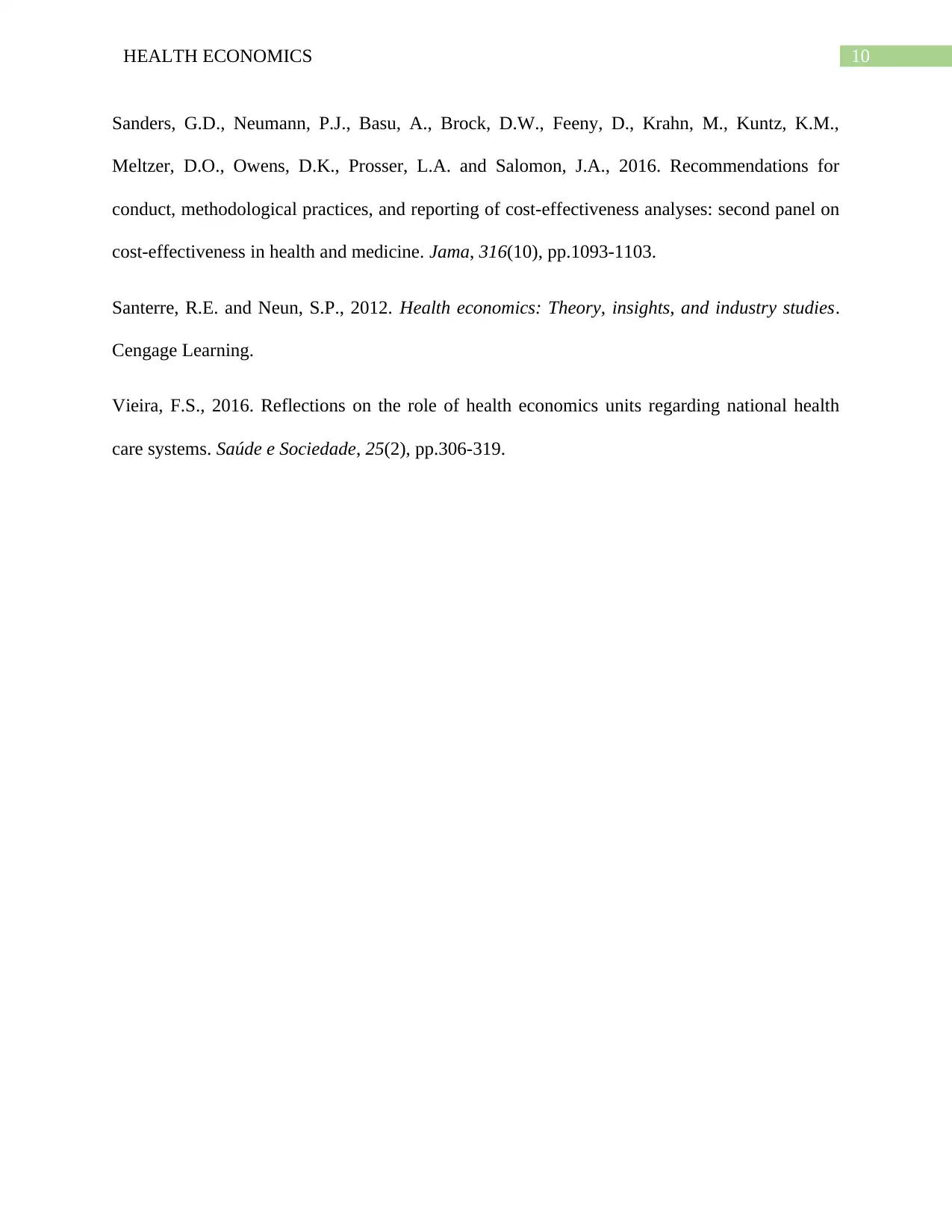
10HEALTH ECONOMICS
Sanders, G.D., Neumann, P.J., Basu, A., Brock, D.W., Feeny, D., Krahn, M., Kuntz, K.M.,
Meltzer, D.O., Owens, D.K., Prosser, L.A. and Salomon, J.A., 2016. Recommendations for
conduct, methodological practices, and reporting of cost-effectiveness analyses: second panel on
cost-effectiveness in health and medicine. Jama, 316(10), pp.1093-1103.
Santerre, R.E. and Neun, S.P., 2012. Health economics: Theory, insights, and industry studies.
Cengage Learning.
Vieira, F.S., 2016. Reflections on the role of health economics units regarding national health
care systems. Saúde e Sociedade, 25(2), pp.306-319.
Sanders, G.D., Neumann, P.J., Basu, A., Brock, D.W., Feeny, D., Krahn, M., Kuntz, K.M.,
Meltzer, D.O., Owens, D.K., Prosser, L.A. and Salomon, J.A., 2016. Recommendations for
conduct, methodological practices, and reporting of cost-effectiveness analyses: second panel on
cost-effectiveness in health and medicine. Jama, 316(10), pp.1093-1103.
Santerre, R.E. and Neun, S.P., 2012. Health economics: Theory, insights, and industry studies.
Cengage Learning.
Vieira, F.S., 2016. Reflections on the role of health economics units regarding national health
care systems. Saúde e Sociedade, 25(2), pp.306-319.
1 out of 11
Related Documents
Your All-in-One AI-Powered Toolkit for Academic Success.
+13062052269
info@desklib.com
Available 24*7 on WhatsApp / Email
![[object Object]](/_next/static/media/star-bottom.7253800d.svg)
Unlock your academic potential
Copyright © 2020–2025 A2Z Services. All Rights Reserved. Developed and managed by ZUCOL.





